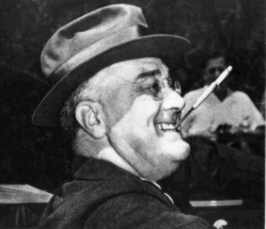|
 Thirty-second President of the United States, Roosevelt had just received an unprecedented nomination for a fourth term from the Democratic Party in Chicago in July 1944. He had come into power in 1933 in the depths of the Great Depression. Trying mightily to turn around the American economy when the Japanese struck Pearl Harbor on December 7, 1941, he also had recognized that the United States had to enter the Second World War ever since the Nazis had invaded Poland in September, 1939. However, he found this was a struggle because of the overwhelmingly isolationist sentiment of the American electorate that had existed since the end of the World War I. Thirty-second President of the United States, Roosevelt had just received an unprecedented nomination for a fourth term from the Democratic Party in Chicago in July 1944. He had come into power in 1933 in the depths of the Great Depression. Trying mightily to turn around the American economy when the Japanese struck Pearl Harbor on December 7, 1941, he also had recognized that the United States had to enter the Second World War ever since the Nazis had invaded Poland in September, 1939. However, he found this was a struggle because of the overwhelmingly isolationist sentiment of the American electorate that had existed since the end of the World War I.
After December 7th, all this changed. The American public united behind the war effort with the battle cry, “Remember Pearl Harbor!” After suffering military setbacks in 1942, the tide turned in favor of the Allies with victories at Midway, Guadalcanal, El Alamein, and Stalingrad in late 1942 and early 1943. On June 6, 1944, the Americans, British, and Canadians landed on the Normandy beaches in northern France and, by July 1944, were fighting their way across the open plains of France toward the German border. The Red Army had won many victories over the German invaders and were now driving the Germans westward toward the German eastern border. There would be many bloody battles to be fought on both fronts before the war in Europe would end. 
Meanwhile, after losing the Philippines, Wake Island, and Guam in those dark days following the Pearl Harbor debacle, the Americans won victories over the Japanese in the Solomon Islands, New Guinea, and the Gilbert, Marshall and Marianas Islands. The big question that faced American war planners was, “Where do we go next?” 
The American Navy wanted to invaded Formosa while General MacArthur wanted to fulfill his pledge to return to the Philippines. The arguments continued to such a point that Roosevelt knew he had to intervene and resolve the situation so the Pacific War could incessantly proceed toward an American victory. So, after leaving his party’s convention, he rode in a train to San Diego where he boarded the heavy cruiser Baltimore and headed to meet General MacArthur and Admiral Nimitz in Hawaii. The only military presence he took with him was his naval advisor, Admiral Leahy. 
After the arrival ceremonies and photo opportunities ended, Roosevelt met with MacArthur and Nimitz to hear their views. While Nimitz presented sound military reasons to invade Formosa, MacArthur won the day by taking advantage of Roosevelt’s political instincts when he said American honor was on the line when he uttered those immortal words on the back of that railroad car in Adelaide, Australia, “I shall return.” The General reminded the President that if America did not honor its commitment to liberate the Philippines, the American electorate would rise up in righteous indignation and vote Roosevelt out of office. Being the political animal that he was, Roosevelt realized on which side his political bread was buttered and gave approval to MacArthur’s plan.
Thus the stage was now set for the invasion of the Philippines and set in motion a series of events that would lead up to the Battle of Leyte Gulf. 
|
